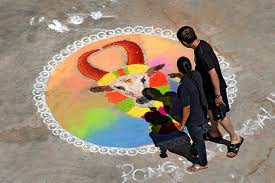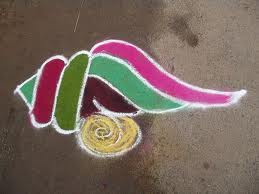Pongal is a harvest festival celebrated with religious fervor across Tamil Nadu, a southern state of India. Thai Pongal, as it is popularly called, is synonymous to Makar Sankranti, the harvest festival celebrated in various regions of India, on 14th of January, every year. Pongal is typically celebrated from 13th of January to 16th of January, every year. The merrymaking starts with Bhogi, the first day of Thai Pongal. Observed as thanksgiving occasion to Lord Indra (the God of Heaven), Bhogi is the day when people burn the old and unwanted materials, like clothing and furbishes. The next day is observed as Surya Pongal, the day dedicated to honor Sun God.
The third day of Pongal is known as Mattu Pongal, wherein people worship farm animals. The fourth day is observed as Kaanum Pongal, which is also known by the name of Karinaal or Thiruvalluvar Day in few places. Sarkarai Pongal is offered to Sun God, as it is one of the important rituals of the fourth day of the festival. Often referred to as ‘Tamil Thirunal’ (the festival of Tamils), Pongal removes the barrier of caste and religion. People, irrespective of their community, celebrate the festival with gusto. Pongal boasts of a vibrant history, which dates back to many centuries. Go through the following lines to get information on the history and origin of Pongal.
History & Origin Of Pongal Festival
The origin of Pongal can be traced back to Sangam Age, a period extending from 200 BC to 300 AD. The festival was celebrated as Thai Niradal. During the period, unmarried girls prayed for agricultural prosperity of the country and for the purpose, they observed penance during the Tamil month of Margazhi, corresponding (December-January). All through the month, they abstained themselves from the consumption of milk and milk products. They didn’t oil their hair throughout the month. The use of harsh words was strictly refrained by them. Ceremonial bath in the early morning was part of the ritual of the penance.
The unmarried women worshipped Goddess Katyayani, one of the nine forms of Ma Durga. They carved image of the deity out of sand. The women broke their fast on the first day of the month of Thai (January-February). It was believed that the fast would bring abundant wealth, prosperity and bountiful crop for the year ahead. Tamil literature has mentioned the celebration of the festival of Thai Niradal and the observance of the penance, known as Pavai Nonbu. Both the festival and the penance were vividly described in Andal’s Tiruppavai and Manickavachakar’s Tiruvembavai. Chola King Kiluttunga used to present lands to the Veeraraghava temple at Tiruvallur, especially for the celebration of Pongal.
Pongal is one of the most important festivals in the state of Tamil Nadu, India. It is the only Hindu festival that follows a solar calendar and is celebrated on a fixed date i.e. the fourteenth of January every year. It is a harvest festival and celebrated in North India as Makar Sankranti. It also has an astronomical significance as it marks the beginning of Uttarayana i.e. the movement of sun in the northern hemisphere. This festival is celebrated for four days in all the Tamil families around the globe. Apart from feasting, people sing and dance on this occasion to express their elation and a beginning of the phase of prosperity and riches. Several kinds of popular Tamil folk dances are performed on this occasion in the temples or at community gatherings. Here in this article, we have discussed few of the dance forms performed on auspicious occasions like Pongal. Read more to know in detail.
Folk Dances On Pongal
Karagaattam
Karagam is a folk dance of Tamil Nadu. It is basically a rural dance which is done along with music either individually or in a pair of two. It is basically a performance of balancing a pot on the head. It is of two types- Aatta Karagam and the other ‘Sakthi Karagam’.
Kummi
Kummi is one of the most popular dances that are performed on the occasion of Pongal. It is also one of the most ancient dances of Tamil Nadu and it is said that it evolved as a dance form even before music. It is a group dance in which women stand in a circle and dance clapping their hands rhythmically to lifting songs.
Mayil Attam
This is also one interesting kind of dance performed by the girls of the state on auspicious occasions. In this dance, the dancer is supposedly dressed as a peacock, with peacock feathers and a sparkling head-dress complete with a beak.
Oyil Kummi
Oyil Kummi is an ancient folk dance form of the state. It is very popular in Trichi, Salem, Dharmapuri, Coimbatore and Periyar districts. This dance is performed exclusively by men without any musical instruments except the ankle-bells. This is popularly performed during all the temple festivals.
Kali Attam
Kali Attam is a folk dance of Tamil Nadu that is performed by both men and women during auspicious days, weddings and joyous festivals like Pongal. Kali literally means joy or fun and games and the dance of Kali Attam is very much a reflection of its name. It is performed along with a stick and is very much an exhibition of quickness and alertness.
Puli Attam
Puli Attam is another Tamilk folk dance that is performed on temple festivals and auspicious occasions like Pongal. This is an entertaining dance form with the main dancer dressed like a lion.
Pongal, the harvest festival of Tamil Nadu, is celebrated with fun and fervor. It is the time, when farmer thank Mother Nature for blessing them with a bountiful harvest. During the festive season, people ensure that their home and premises are kept spick and span. They would get up early in the morning, offer prayers to their favorite deity and make a beautiful kolam (rangoli) at their entranceway. Kolam is an art of drawing images and geometrical shapes on floor, by synchronizing with dots. Drawing kolam is considered auspicious. In fact, no verandah of a Tamil household is left without kolam. Making both simple and intricate designs of kolam on Pongal is a tradition followed since long. Check out more about Pongal rangoli designs, in the following lines.
Pongal Rangoli Designs
Several types of kolam designs are popular for Pongal. You can draw line kolam, which involves free hand drawing of lines, to make a geometrical pattern. Pulli (dots) are arranged in a specific sequence, which is joined to make the particular kolam design. Apart from drawing lines, people also make twisted chains by linking one loop of the kolam with the next, thereby forming wonderful designs. Such a pattern of kolam is popularly referred to as ‘Chuzhi Kolam’. The art is also popular in other states, where it is known by different names. In Bengal, it is known as Alpana, while in Rajasthan, it is popularly known by the name ‘Mandana’. People in Andhra Pradesh call it ‘Muggulu’, while in Maharashtra and Karnataka it is called ‘Rangoli’.
Although the designs may vary, the basic idea of kolam remains the same – to draw beautiful designs on floor, using dry colors of rice flour. The tradition of making kolams on Pongal is not new to the Tamil people. Its history can be traced back to the Indus Valley Civilization in 2500 BC, when people used to make elaborate designs of kolam are made using white and other color powders and rice flour. According to the legends, Gopis used to make rangoli to lessen their pain for not having Lord Krishna with them. Since a long time, kolam has been made in ceremonious occasions in Tamil Nadu.
The First Day
The first day of Pongal is devoted to Lord Indra, who is the supreme ruler of clouds that give rain. People pay homage to Lord Indra for the abundance of harvest and prosperity to the land. There is a custom of throwing useless household articles into a fire, made of wood and cow-dung cakes. Girls are seen dancing around the bonfire and singing songs in praise of the God.
The Second Day
On the second day of Pongal, a puja is performed. Rice is boiled in milk, outdoors – in an earthenware pot, and is symbolically offered to the Sun God, along with other oblations. On this day, husband and wife dispose off elegant ritual utensils, specially used for the puja. There is a ritual of tying turmeric plant around the pot in which the rice will be boiled. The offerings include coconut and bananas in a dish, with two sticks of sugar-cane in background.
The Third Day
It is also known as Mattu Pongal, the day when cattle are worshipped. The cattle are decorated with multi-colored beads, tinkling bells, sheaves of corn and flower garlands. They are fed with Pongal and taken to the village center, where the young men race each other’s cattle. It makes the atmosphere more festive and full of fun. Later on, aarti is performed.
The Fourth Day
The final day of Pongal celebration is known as Knau or Kannum Pongal. On this day, a turmeric leaf is washed and kept on ground. The left over of sweet Pongal and Venn Pongal, ordinary rice as well as rice colored red and yellow, betel leaves, betel nuts, two pieces of sugarcane, turmeric leaves, and plantains are placed on it. All the women assemble in the courtyard and pray for the prosperity of their brother. An aarti is performed with turmeric water, limestone and rice and the items are sprinkled on the kolam in front of the house.












Leave a Reply